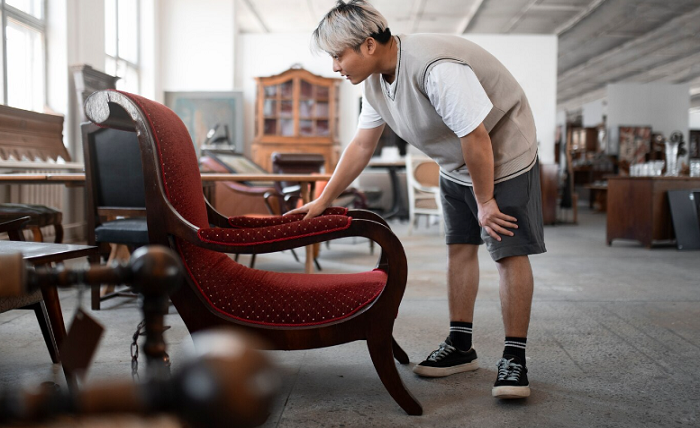Throughout the world, commercial furniture significantly impacts how practical and aesthetically pleasing office environments are. Beyond simple practicalities, it has become a significant component of branding, staff wellbeing, and customer experience. In this article, we dig into the intriguing world of commercial furniture, tracing its origins throughout history, analyzing current trends, and assessing its effects on businesses.
HISTORICAL PERSPECTIVE
- ANCIENT BEGINNING
Ancient civilizations have a long history of producing commercial furniture. The significance of furniture in business places has been clear for millennia, from the elaborate chairs made by the Egyptians to the basic yet attractive designs created by the Greeks. These early objects frequently had practical and ornamental functions and symbolic and utilitarian importance.
- MEDIEVAL ERA
Commercial furniture had substantial growth during the middle Ages. Churches and monasteries were among the first commercial buildings that needed specialized furnishings like seats and lecterns. As commerce grew, guilds formed, encouraging skilled labor and creative furniture design.
- RENAISSANCE BAROQUE ERAS
Furniture design flourished during the Renaissance and Baroque eras. Rich palaces and aristocratic estates had lavish furnishings that demonstrated the position and riches of their owners. The merging of beauty and practicality in commercial furniture was pioneered during this time.
TURNING POINT
- THE DAWN OF PRODUCTION
The development of business furniture underwent a critical turning point during the Industrial Revolution. The industry adopted mass production by introducing factories and assembly lines, enabling the manufacturing of standardized items on a previously unthinkable scale. This accessibility transformed the furniture industry by opening high-quality designs to a
- MASS PRODUCTION larger market.
The manufacturing of business furniture underwent a fundamental shift during the Industrial Revolution. The emergence of factories and assembly lines made producing standardized goods in large quantities possible. Due to increased accessibility, more people now have access to high-quality designs, revolutionizing the furniture sector.
- THE BIRTH OF ICONIC STYLE
During the late 19th and early 20th centuries, enduring furniture designs like Art Nouveau and Art Deco emerged. Famous designers like Le Corbusier, Charles, and Ray Eames pioneered cutting-edge ideas prioritizing comfort, shape, and functionality. These innovative designs are still having a significant impact on contemporary office furniture.
- MODERN COMMERCIAL FURNITURE TREND
- ERGONOMICS
Ergonomics is a crucial component of modern business furniture design. Ergonomic chairs, adjustable desks, and workspace accouterments have grown commonplace in workplaces worldwide as employers become more concerned with their staff’s health and wellbeing. These layouts increase output while lowering the risk of musculoskeletal problems.
- SUSTAINABILITY
Modern business furniture design is motivated by sustainability. Manufacturers are embracing recyclability, eco-friendly materials, and ethical manufacturing practices. The change to sustainable practices aligns with the rising demand from consumers and businesses for goods that respect the environment.
- FLEXIBLE WORKSPACE
Flexible offices have become more popular, particularly after the COVID-19 epidemic. For example, modular seats and collaborative tables may be easily reconfigured to fit changing work situations and encourage adaptation.
- BIOPHILIC DESIGN
Natural elements are incorporated into commercial facilities using biophilic design concepts. Furniture made of organic materials, textures, and flora encourages interaction with nature. This design strategy has increased worker creativity, productivity, and wellbeing.
IMPACT OF COMMERCIAL FURNITURE ON BUSINESS
- BRAND IDENTITY
A company’s brand identity is significantly shaped by its commercial furnishings. The furniture chosen may convey a brand’s culture, personality, and ideals. Rustic, recycled furniture may highlight sustainability and authenticity, while sleek, contemporary pieces may communicate innovation.
- EMPLOY PRODUCTIVITY AND WELL BEING
The productivity and wellbeing of employees are directly impacted by well-designed business furniture. Desks with adjustable heights and ergonomic seats encourage physical comfort, lowering the likelihood of weariness and pain. Employee morale and creativity may be raised by providing comfortable and functional workstations.
The productivity and wellbeing of employees are directly impacted by carefully crafted business furniture. Desks with adjustable heights and ergonomic seats provide physical comfort, lowering the likelihood of weariness and pain. Cozy and practical workspaces also boost employee morale and creativity, improving overall job satisfaction.
- CUSTOMER EXPERIENCE
Proper furniture influences customer experience for organizations in the retail and hospitality industries. Longer stays and recurring business can be encouraged through welcoming rooms with comfortable seating, attractive décor, and strategically placed furnishings.
- SPACE OPTIMIZATION
Space utilization is a crucial factor in business settings. Businesses may adjust to changing demands and handle variable audience sizes by using furniture that maximizes space, such as stackable seats or folding tables.
FUTURE OF COMMERCIAL FURNITURE
- TECHNOLOGICAL INTEGRATION
The future holds the incorporation of technology into office furniture. IoT sensors and wireless charging capabilities in innovative furniture will improve connection and convenience for consumers.
- SUSTAINABLE INNOVATION
The future of commercial furniture will continue to be shaped by the quest for sustainability. The sector’s environmental impact will be further diminished through innovations in production methods and materials.
- PERSONALIZATION
It will be easier to get customized furniture options catering to the unique requirements of organizations and people. Modular construction and adaptable designs will give designers more freedom to create distinctive commercial spaces.
CONCLUSION
Commercial furniture has changed from functional, status-based emblems to sophisticated, sustainable designs influencing current organizations. It affects brand identity, staff satisfaction, and consumer experiences, and its future looks to integrate sustainability and technology further. Business furniture will continue to be a vital and dynamic component of business environments worldwide as long as we prioritize utility, aesthetics, and sustainability.

